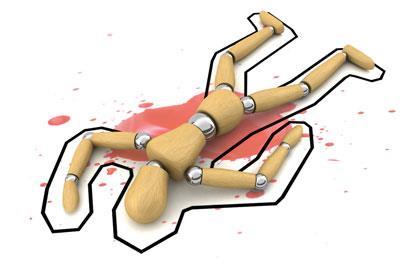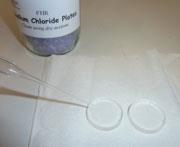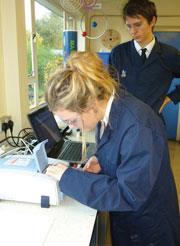Tracy McGhie explains how your students can solve a murder mystery using state-of-the-art equipment
Update: Our Spectroscopy in a Suitcase programme was discontinued in 2020.
As the Spectroscopy in a Suitcase coordinator based at the University of Leicester, I have been involved in the project since 2008. The concept was developed by Jonny Woodward and Paul Cullis of the University of Leicester, who wanted schools and colleges to be able to give their pupils and students hands-on experience of state-of-the-art, university-grade spectroscopy equipment - enhancing the teaching of spectroscopy and chemistry in secondary education.

Since its initial trial in just three UK regions, I have watched the project go from strength to strength. Under the administration of the RSC, Spectroscopy in a Suitcase now covers every region of the country - thanks largely to funding from Higher Education Funding Council for England (HEFCE), as part of the Chemistry for our Future and national HE STEM programmes, and the National Science Academy of Wales. Industrial support from the likes of Bruker, Thermo Fisher Scientific and Sigma-Aldrich has also played a part.
This country-wide coverage makes use of 17 sets of suitcase apparatus and offers workshops and activities that are delivered by 19 partner universities. Over the last three years, the project has exceeded all targets by delivering activities to over 26 000 students through more than 520 events. With teachers keen to secure repeat bookings, the success and popularity of Spectroscopy in a Suitcase is clear for all to see.
Spectroscopy is part of the GCSE, BTEC and AS/A2 syllabuses, and can be an important and engaging subject for students. But the high costs of instrumentation means that most schools and colleges do not have access to the right equipment for effective hands-on learning. Spectroscopy in a Suitcase workshops show students the kind of practical work that will be found in a typical chemistry degree, raising aspirations and providing a glimpse into the world of higher education and illustrating some of the real-life uses of chemistry in industry.
The project also helps widen participation by breaking down barriers to higher education: students have the opportunity to use and understand university-level equipment, and enjoy direct contact with postgraduate student ambassadors, who are able to answer more general questions about life at university. This use of student ambassadors has proved to be one of the key success factors for the project.
A typical workshop

Spectroscopy in a Suitcase workshops are free and requests to book one can be made on the RSC website. Once such a request is received, a coordinator contacts the teacher in charge to arrange a suitable date and agree the activities to be included.
The most popular activity is the analysis of unknowns using FT-IR spectroscopy, which usually takes around two hours, depending on the lesson length and student numbers. Each workshop comfortably caters for 10-24 students, allowing plenty of opportunity for hands-on activity. The primary target audience is year 12 or 13, studying at BTEC or A-level.
The FT-IR workshop also forms part one of the popular three-part murder mystery activity: a body (Mr Blue) has been found in a lab, and the students must identify the unknown chemicals found in the vicinity of his body, including a mystery medicine found in his pocket. In part two students use the Beer-Lambert law and a UV/visible spectrometer to work out the concentration of the mystery medicine in the victim's blood plasma. Finally they read and analyse witness statements and mass spectrometry data to arrive at a conclusion about what caused our victim's death, and who the most likely perpetrator would be.
On arrival at the school or college, the spectroscopy equipment is set up in the classroom or laboratory. This takes about 20 minutes, including the FT-IR spectrometer's internal calibration checks, so it is important that a classroom is available a little time before the workshop is due to start. If possible a ground-floor lab is always preferred for ease of access.
Getting familiar with infrared
A brief outline of infrared spectroscopy is given using a poster presentation, although students get the maximum benefit from the workshop if they have been taught the theory of infrared spectroscopy and mass spectrometry by their teacher in advance.

In the FT-IR spectra they run themselves, students look for peaks that give them functional group information, such as O-H and C=O stretches. Using the mass spectrometry data from the provided workbook, including the molecular ion and fragmentation peaks, students try to work out the structure and name for each of the molecules they sample. University ambassadors will be on hand to guide them through the process. Familiarity with the functional groups associated with alcohols, carboxylic acids, aldehydes, ketones and esters will be helpful to the students, along with knowledge of the structure of a benzene ring.
When assembling the equipment, the ambassadors set up workstations for groups of two to three students, with each station having a set of pure sodium chloride plates for preparation of liquid samples for FT-IR analysis. Students are shown how to prepare a sample (with just one drop between the two plates) and how to clean the plates carefully with solvent, ready for the next sample.

Once a student has prepared their samples they take it to the FT-IR instrument, record its spectrum following simple on-screen instructions, and print the results for analysis. During this process the students are taught to take key information from the IR spectrum. A paper copy of relevant mass spectra is also given to the students, and they learn to use common mass fragments, along with empirical formulae, to piece together the jigsaw and come up with complete molecular structures.
By the end of the session, it's not uncommon to have seen a few 'lightbulb moments', where the theory they have studied in isolation now slots into place alongside the practical techniques they have learned. Students also find out that it is not necessary to identify every single peak in the spectrum, just the key peaks that tell them something useful, and that the different analytical techniques have different strengths and weaknesses.
Group work

Once all the liquid samples have been analysed, the students work as a group to identify the solid samples, including the medicine found at the scene of the crime, in the case of the murder mystery workshop. For this they have the opportunity to use an attenuated total reflectance (ATR) attachment, which enables the direct FT-IR spectroscopy of solid substances by bouncing infrared light through a diamond crystal covered in the sample, and back to the detector using mirrors. The solid samples are ground to a fine powder, placed carefully on the diamond ATR surface and pressure is applied via an overhead arm.
For this part of the practical, the students ask the computer to search its database to find the best match for the compound, rather than working out its identity from first principles. So far, in the five years worth of workshops I have run, the correct answer has been delivered every time, with just one exception: on one occasion, for some unknown reason, the computer suggested cocaine instead of aspirin as the best match. Not a very good match, but most amusing for the students. I assured their teacher that the white powder we had just sampled definitely wasn't illegal. Such results do illustrate the valuable point that such database answers are only a best match, and not to be believed without question.
The infrared spectroscopy session usually finishes with a roundup of the results. Students take turns to discuss how they arrived at their answers, in their groups, for each of the individual samples.
Murder mystery part II: UV-vis spectroscopy
The UV-visible spectroscopy experiment is accompanied by a variety of practical resources, which are designed for a range of ages. These include kinetics, food dyes and Beer-Lambert plots, however the most popular activity is the second part of the murder mystery story.
Running the full murder mystery takes about two and a half hours, and is often booked by schools that have triple lessons or are off-timetable on a special activity day. The practical is based around a Beer-Lambert plot, demonstrating to students the proportionality of absorbance and concentration. Students prepare a series of calibration standards by measuring the absorbance of known concentrations, and use this data to make a straight-line calibration graph in Microsoft Excel. This graph is printed and used by the students to determine the absorbance of unknown concentrations in the victim's blood plasma.
Workstations include the calibration solutions, an iron(iii) chloride complexing solution and auto pipettes and tips. We find students love using the auto pipettes as it makes them feel very 'CSI' as they prepare their solutions for analysis.
Once they have determined the drug concentration in the blood plasma sample, they have to decide if the victim took a therapeutic or lethal dose.
Murder mystery part III: mass spectrometry

With the practical work complete, the final part of the murder mystery involves a paper-based exercise in which students use supplied mass spectrometry data and witness statements to determine the cause of death. Workshop participants also identify the killer from one of four key suspects. This part of the workshop usually causes lots of discussion between the peer groups as they come up with theories and possible scenarios for Mr Blue's death. The idea is to teach the students to use the scientific evidence to construct their theory, and to support or eliminate the suspects accordingly.
Since its inception I have thoroughly enjoyed organising and delivering these Spectroscopy in a Suitcase workshops. It's great to see the students enjoying chemistry as they take up the challenge of solving a classic 'who dunnit?' Running their own samples engages the students and helps to make textbook theory come to life. An additional consequence of the project is that university staff and students also benefit from the opportunity to visit schools, gaining a greater understanding of the sector and forging stronger links with local schools and colleges.
Feedback and comments from Spectroscopy in a Suitcase workshops
From students
- Great fun - it has shown what is required when attending university.
- Nice to see chemistry in action, rather than just read about spectroscopy in the textbook.
- Thank you very much! This has helped me understand this topic a lot more and I enjoyed it immensely.
- It was very informative, has helped me make a clear decision on what I wish to study at university.
- What I liked best was the opportunity to question the team on their work and experience of doing this at university.
From teachers
- Being able to see the equipment we usually only talk about, and being able to use it. I found it useful as a member of staff: the ability to see modern techniques linked to a computer really added to the event. D Hill
-
[I'm] impressed with the resources on SpectraSchool. The material, animations, spectra, etc are just the ticket. Maurice Christie
Further reading
- The Spectroscopy in a Suitcase resources discussed in this article are available to view and download









No comments yet